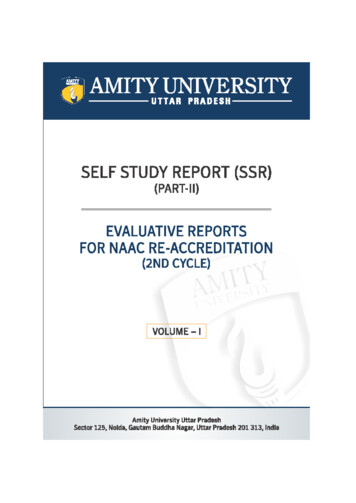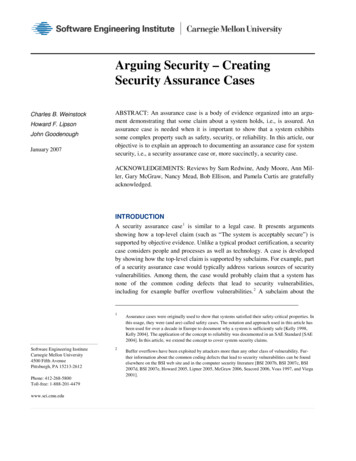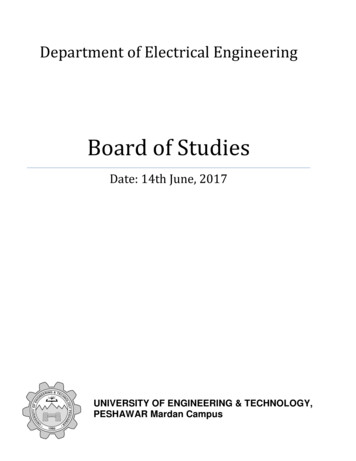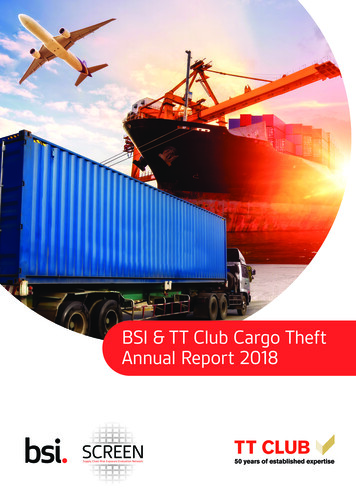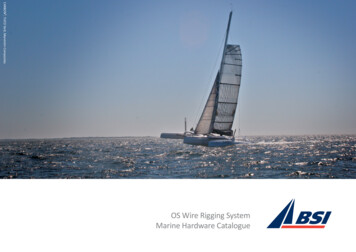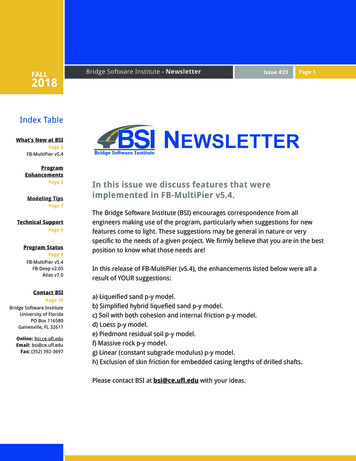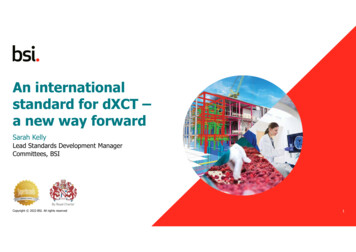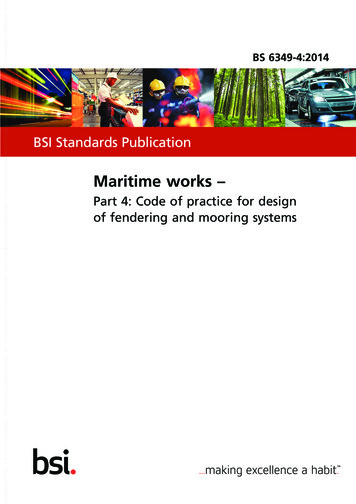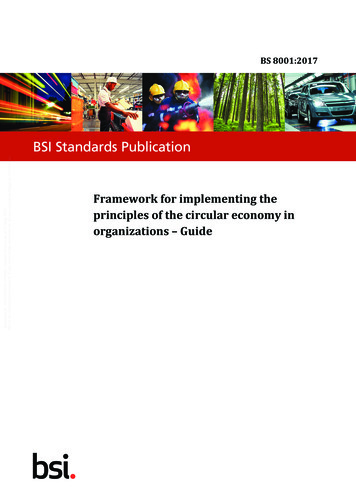
Transcription
BS 8001:2017BSI Standards PublicationFramework for implementing theprinciples of the circular economy inorganizations – Guide
BS 8001:2017 BRITISH STANDARDPublishing and copyright informationThe BSI copyright notice displayed in this document indicates when the document was last issued. The British Standards Institution 2017Published by BSI Standards Limited 2017ISBN 978 0 580 92644 0ICS 03.100.01The following BSI references relate to the work on this document:Committee reference SDS/1/10Draft for comment 16/30342022 DCAmendments/corrigenda issued since publicationDateText affected THE BRITISH STANDARDS INSTITUTION 2017 – ALL RIGHTS RESERVED
BRITISH STANDARD BS 8001:2017Contents PageForewordSection 3Section roductionOverview of this British StandardFigure 1 — Overview of the framework for implementing the principles of the circular economyGeneralFigure 2 — Circular economy schools of thoughtFigure 3 — The circular economy at a glance – optimizing value creation through circularityRelationship with resource efficiencyRelationship with zero wasteRelationship with the bioeconomyRelationship with lean thinkingOutcomesScopeTerms and definitionsFigure 4 — Conceptual example of a cascade systemFigure 6 — Conceptual simplified example of a closed loop systemFigure 7 — Conceptual simplified example of an open loop systemThe circular economy and its relevance to organizationsGeneralCircular economy benefits for organizationsMacro‑level benefitsImproved resilience of economic systemsEconomic growth and employmentPreserved natural capital and climate change mitigationMicro‑level benefitsGeneralCost savingsNew sources of innovation and revenueImproved customer relationshipsImproved resilience for organizationsImplementation challenges for different types of organizationsGuiding principlesPrinciples of the circular economyGeneralPrinciplesSystems thinkingFigure 9 — General concept of an organizational system with intervention highlightedInnovationStewardshipCollaborationValue 3232323232323242424252626262828282929293031 THE BRITISH STANDARDS INSTITUTION 2017 – ALL RIGHTS RESERVED i
BS 8001:2017 Section 355.15.25.35.45.55.65.75.85.95.105.11Section .47.57.67.77.87.97.107.117.127.137.147.15iiBRITISH STANDARDFlexible frameworkFramework for implementing the principles of the circular economyGeneralEstablishing an organization’s level of circular economy maturityFigure 10 — Level of organizational circularity maturityThe eight‑stage flexible frameworkFigure 11 — Navigation tool to help organizations identify where to start in using the eight‑stageflexible frameworkStage 1: FramingStage 2: ScopingStage 3: Idea generationStage 4: FeasibilityStage 5: Business caseStage 6: Piloting and prototypingStage 7: Delivery and implementationStage 8: Monitor, review and reportSupporting guidanceGuidance on enabling mechanisms and business modelsGeneralEnabling mechanismsBusiness model designGeneralKey elementsFigure 12 — Overview of business model developmentBusiness model types and selectionGeneralPreferenceBusiness model groupingsTable 1 — Overview of business modelsGuidance on circular economy issues and considerationsGeneralTable 2 — Example matrix to help organizations to identify potential issues and considerationsrelating to progressing their circular economy vision, strategy or objectivesAccounting and financeAnti‑trust and competition lawChange managementChemicalsEnergy and fuelsTable 3 — Common methods for extracting energy from non‑hazardous residual wasteInformation managementLiability and insuranceLogistics and reverse logisticsMarketingMaterials marketsMaterials selectionMonitoring and measurementProcurement and contract managementProduct design and development THE BRITISH STANDARDS INSTITUTION 2017 – ALL RIGHTS 44444545454547515152525354555657585960616263646566
BRITISH STANDARD 7.16Annex AAnnex BBS 8001:2017Figure 13 — Illustrative influence on environmental impact during design and the cumulativeimpact during product life cycle stagesWaste regulation6768Evaluating implementation of the principles of the circular economyTable A.1 — Example maturity model for organizational circularityTable A.2 — Questions to help organizations consider how the principles of the circular economyare being realized through their decisions and activities (non‑exhaustive)7071Potential circular design strategies and checklistTable B.1 — Design focus areas and potential design strategiesTable B.2 — Non‑exhaustive checklist of options for design improvement matched to designfocus areas7777Bibliography737879Summary of pagesThis document comprises a front cover, and inside front cover, pages i to iv, pages 1 to 81, an inside back coverand a back cover. THE BRITISH STANDARDS INSTITUTION 2017 – ALL RIGHTS RESERVED iii
BS 8001:2017 BRITISH STANDARDForewordPublishing informationThis British Standard is published by BSI Standards Limited, under licence from The BritishStandards Institution, and came into effect on 31 May 2017. It was prepared by Technical CommitteeSDS/1/10, Sustainable resource management. A list of organizations represented on this committeecan be obtained on request to its secretary.Use of this documentAs a guide, this British Standard takes the form of guidance and recommendations. It should notbe quoted as if it were a specification or a code of practice and claims of compliance cannot be madeto it.Although this British Standard is primarily intended to be used in the UK, it is expected that many ofits provisions and guidance will be applicable in other jurisdictions.Presentational conventionsThe guidance in this standard is presented in roman (i.e. upright) type. Any recommendations areexpressed in sentences in which the principal auxiliary verb is “should”.Commentary, explanation and general informative material is presented in smaller italic type, and doesnot constitute a normative element.Where words have alternative spellings, the preferred spelling of the Shorter Oxford EnglishDictionary is used (e.g. “organization” rather than “organisation”).Contractual and legal considerationsThis publication does not purport to include all the necessary provisions of a contract. Users areresponsible for its correct application.Compliance with a British Standard cannot confer immunity from legal obligations.iv THE BRITISH STANDARDS INSTITUTION 2017 – ALL RIGHTS RESERVED
BRITISH STANDARD BS 8001:2017Section 1: General0 Introduction0.1 Overview of this British StandardThis British Standard is intended to help organizations and individuals consider and implementmore circular and sustainable practices within their businesses, whether through improved ways ofworking, providing more circular products and services or redesigning their entire business modeland value proposition.This standard aims to provide a framework and guidance to a broad range of organizations, ofdiffering sizes and with varying levels of knowledge and understanding of the circular economy.Starting with smaller, “quick‑win” type initiatives can be a good way for organizations new to thecircular economy to gain relevant experience and confidence.The standard is divided into two areas:1)2)What is the circular economy and why move to a more circular and sustainable mode ofoperation? Clause 3 aims to help organizations improve their understanding of the circulareconomy and how it might be relevant.How to implement the principles of the circular economy within an organizational context?These sections form the majority of the standard and Figure 1 provides an overview of the keyelements which are classified as “Guiding principles”, “Flexible framework” and “Supportingguidance”. Guiding principles: Clause 4 outlines the principles of the circular economy which underpinthe flexible framework and provides a strategic frame of reference for how closely decisionmaking and activities align with the guidance provided.Flexible framework: Clause 5 provides a flexible framework for organizations to use todetermine the extent to which they intend to implement the principles of the circulareconomy and transition to a more circular and sustainable mode of operation.Supporting guidance: Clause 6 and Clause 7 provide supporting guidance and are intendedto be read alongside Clause 5. These clauses provide guidance on enabling mechanisms andbusiness models that can support the transition to a more circular and sustainable modeof operation, as well as key factors which it might be relevant to consider when using theframework.Many elements of the framework and guidance have been developed by drawing on experiencesand lessons learned from a range of organizations, both small and large, attempting to become morecircular. Many aspects mirror what could be thought to be the basics of good sustainable businesspractice, but in this standard they are solely being examined from a circular economy perspective. THE BRITISH STANDARDS INSTITUTION 2017 – ALL RIGHTS RESERVED 1
BS 8001:2017 BRITISH STANDARDFigure 1 — Overview of the framework for implementing the principles of the circular economyKeyGuiding principles (Clause 4)Flexible framework (Clause 5)Supporting guidance (Clause 6 and Clause 7, plus annexes and bibliography)0.2 GeneralNatural resources, including materials, water, energy and fertile soil, are the basis for sustainingsociety. However, the activities of the large and growing human population is rapidly eroding manyof the world’s natural resources, while a large part of an increasingly urban global population is stillstruggling to meet basic needs.Over the next 30 to 40 years unprecedented volatility and uncertainty seems likely. The globalpopulation is estimated to increase to around 8 billion by 2030, probably to over 9 billion by 2050,with increases in average wealth further raising the demand for products and services. As a result,2 THE BRITISH STANDARDS INSTITUTION 2017 – ALL RIGHTS RESERVED
BRITISH STANDARD BS 8001:2017competition for land, water and energy could intensify while the effects of climate change are likelyto become increasingly apparent. Over this period, organizations are likely to face technologicaldisruption, increasing trade barriers and intense competition for a wide range of material resourcesthat become less easily available (which might also be due to geopolitical factors). Even today, somematerials, such as rare earth elements and other critical raw materials, are already subject to supplypressure and price volatility.To ensure the availability of resources in the future, current patterns and volumes of production andconsumption need to change dramatically so that they are brought back. within planetary boundaries.To do this while continuing to thrive as a society, a complete re‑think of how things are done isneeded. Transitioning to a circular economy could offer a significant contribution to solving theemerging resource and climate problems and create opportunities for shared value.In an organizational context, the circular economy refers to a systemic approach to the designof processes, products/services and business models, enabling sustainable economic growth bymanaging resources more effectively as a result of making the flow of materials more circular andreducing and ultimately eliminating waste. The energy required to fuel this needs to be extremelyefficient and renewable by nature. As a term, the circular economy is increasingly gaining tractionin business as more organizations recognize that the traditional, linear “take, make, use, dispose”(or “cradle to grave”) economic model is potentially reaching its limits and the availability of cheap,easily accessible materials and energy can no longer be taken for granted. The economic benefitsof improved circularity of resource use are also increasingly being recognized and acted upon bygovernments around the world (see, for example, the EU action plan for the circular economy [1]).The circular economy is not a new concept. It blends the principles of multiple schools of thought,some of which date back to the 1960s. These include: industrial ecology and symbiosis, performanceeconomy, biomimicry, cradle to cradle, blue economy, regenerative design and natural capitalism (seeFigure 2). More recently, the Ellen MacArthur Foundation (EMF) has been widely credited as playinga pivotal role in engaging the business, policy and education community, focusing on the key pressurepoints and levers that can accelerate the transition to a circular economy.NOTE See the following publications for further information on these schools of thought: Graedel and Allenby,2002 [2] and Ayres and Ayres, 2002 [3] for industrial ecology; Chertow, 2007 [4] for industrial symbiosis; Staheland Redray, 1976 [5] and Stahel, 2006 [6] for performance economy; Benyus, 1997 [7] for biomimicry; McDonoughand Braungart, 2008 [8] and McDonough and Braungart, 2013 [9] for cradle to cradle; Pauli, 2010 [10] for blueeconomy; Lyle, 1996 [11] for regenerative design and Hawken, Lovins and Lovins, 2010 [12] for natural capitalism.Because the idea of a circular economy proposes a real paradigm shift and a different way of thinkingabout the economy, it cannot easily be reduced to one simple definition. As a result, there are variousinterpretations of the idea across organizations, together with an abundance of terminology, oftenmisused or used interchangeably. This adds to the complexity of the concept, which can in turn deterorganizations seeking to improve how they manage resources.This British Standard focuses on the circular economy as it is relevant for organizations. The centraltenet is to take full advantage of the reusability of products, components and materials, the restorativeand regenerative capacity of natural resources and to optimize value creation (both directly andindirectly). It is an approach which promotes optimal use of resources, reuse, repair, refurbishing,remanufacture and the recycling of materials and products (shown conceptually in Figure 3),as well as the preservation and regeneration of natural capital by returning biological nutrientsinto the biosphere. Process and product or service design and innovation (e.g. for repair, reuse,recyclability) can be complemented by business model design and innovation using approaches suchas performance‑based models to manage how products and materials circulate within the system. THE BRITISH STANDARDS INSTITUTION 2017 – ALL RIGHTS RESERVED 3
BS 8001:2017 BRITISH STANDARDFigure 2 — Circular economy schools of thoughtIn theory, the smaller the loop (activity‑wise and geographically) the more profitable and resourceefficient it is likely to be. For example, it might be that the nearer to their original state products,components and materials can be kept the more value can be captured through the avoidance ofprocessing, transport and other costs. However, in practice, which loop is best for an organizationdepends on the specific circumstances and a wide range of business risks or consequential impactsneed to be considered (e.g. sourcing and geopolitical risks, energy usage and costs, environmentaland social impacts, complexity, geographic scope, organizational capability, economic viability/returnon investment).In the circular economy, materials should not be discarded as wastes, but treated as raw materialswith inherent value. The prevailing policy and legislative landscape, changing economics andemerging technologies can ultimately play a major part in deciding how far the transition to full reuseand recovery of material can be achieved. Ultimately, the circular economy is about organizations“turning things on their head” and completely re‑thinking how resources are managed in order toenhance financial, environmental and social benefits, both in the short and long term.4 THE BRITISH STANDARDS INSTITUTION 2017 – ALL RIGHTS RESERVED
BRITISH STANDARD BS 8001:2017Figure 3 — The circular economy at a glance – optimizing value creation through circularity0.3 Relationship with resource efficiencyResource efficiency needs to be embodied within a circular economy approach. Whilst resourceefficiency and the circular economy are sometimes referred to interchangeably, there are some distinctdifferences. Resource efficiency does not necessarily challenge the linear model of consumption andproduction.Resource efficiency is a broad umbrella term used to describe efforts to reduce the total environmentalimpact of the consumption and production of products and services, from raw material extraction tofinal use and disposal. In a materials context, it is concerned with the efficient use of materials, wasteprevention and reduction, and causing minimal damage to the environment and depletion of naturalresources. It means doing more with less and delivering greater value with less input.Organizations might become more resource efficient through relatively simple, incrementalactions. A circular economy takes a whole systems perspective, where resources are systematicallyrestored or regenerated. It means being more effective and optimizing how resources are managed THE BRITISH STANDARDS INSTITUTION 2017 – ALL RIGHTS RESERVED 5
BS 8001:2017 BRITISH STANDARDacross their life cycle in order to have a positive impact on the natural environment and society.Implementing its principles in an organization might require a paradigm shift in how an organizationoperates.0.4 Relationship with zero wasteOver the last few decades, zero waste has become an aspirational goal for transitioning from a“throw‑away” society. Several high profile businesses around the world have set zero waste targets,orientated predominately around sending nothing to landfill. A number of cities around the worldhave also adopted zero waste goals as part of their waste management strategies.Zero waste is a philosophy that encourages the re‑design of resource life cycles so that all materialsand products are reused or recycled. It discourages the use of waste to energy, incineration or landfill,and ultimately seeks to eliminate the concept of waste altogether. In practice however, the conceptcan be perceived as waste focused and has been applied loosely and inconsistently. For example,zero waste claims have been made solely on the basis of 100% landfill diversion made possible byrelying disproportionately on waste to energy or by not reporting wastes generated throughout thesupply chain.NOTEFor further information on zero waste, see http://zwia.org [last viewed 9 May 2017].Whilst zero waste does not necessarily lead to more circular solutions, if applied with the rightmind‑set the concepts are complementary and it is possible to progressively step towards a circulareconomy.0.5 Relationship with the bioeconomyThe bioeconomy or bio‑based economy refers to parts of the economy that use renewableresources which are biological in nature from land and sea (such as crops, forests, fish, animals andmicroorganisms) to produce food, materials and energy.The bioeconomy is defined by the origin of the resources, not their management or use. Biologicalresources can be used or reused to make new products, components or material (e.g. paper or card)or returned to the biosphere in a way that rebuilds natural capital (through composting or anaerobicdigestion, for instance).The circular economy covers all renewable and non‑renewable resources. There is a perception thatthe bioeconomy is inherently circular because biological resources are renewable. In practice, it canbe quite linear because it is possible for resources to be used faster than they are replenished andmight not be returned safely and appropriately to the biosphere to rebuild natural capital. However,a circular bioeconomy has a major role to play in helping the transition away from using fossil andother finite resources through the provision of bio‑based products which can managed via thebiological or technical cycles.0.6 Relationship with lean thinkingLean thinking describes a holistic continual improvement approach to creating more value forcustomers with fewer resources. Lean organizations aim to use fewer human resources, less materialto create products, less time to develop them and less energy and space to produce them. Lean isfocused on customer demand and developing high quality products and services in the most effectiveand economic way. Although lean thinking is most commonly associated with manufacturing andproduction, it can be applied to all aspects of an organization including internal functions, supplychains and the organization’s wider value chains.6 THE BRITISH STANDARDS INSTITUTION 2017 – ALL RIGHTS RESERVED
BRITISH STANDARD BS 8001:2017Lean thinking has enabled many organizations to deliver high‑quality products and services at lowercost. However, this does not necessarily mean that circular opportunities will be identified and actedupon and lead to positive systemic change.Whilst the circular economy and lean thinking both aim to eliminate waste, they approach it fromdifferent perspectives. Lean focuses on removing anything that does not add value to the customer,whereas the circular economy is about re‑thinking and optimizing how resources are managed tocreate value in its broadest sense. However, as with many initiatives, what’s achieved very muchdepends on the organization’s level of ambition. If approached with the right mindset, the circulareconomy could be a natural extension of lean thinking. It would involve thinking systemically abouthow resources are or could be managed. Many of the tools and techniques advocated by lean thinking(e.g. value stream analysis and future state mapping) have the potential to be adapted in this regard. Itis also likely that implementing the principles of the circular economy would enhance lean outcomes.0.7 OutcomesThis British Standard aims to give guidance to organizations of all types and sizes, wherever theyare in the world, on the steps they can take to transition to a more circular and sustainable mode ofoperation. Specifically, it aims to provide organizations with an understanding of:a)b)what the circular economy is and how it might be relevant both now and in the future; andhow to implement the principles of the circular economy in order to create direct and indirectvalue as a result of process, product or service or business model innovation.Implementing the principles of the circular economy offers organizations an opportunity to re‑thinkhow they do business, potentially enabling them to be more circular, sustainable and competitive.For example, business opportunities could arise from understanding resource use and adopting newways of working, both internally and across the value chain.Progress can be achieved through:1)the identification and effective management of current and future business impacts, risks andopportunities to improve resilience, avoid environmental harm and drive societal benefits;3)strengthening relationships through effective collaboration with the value chain;2)4)5)making the most of resources while minimizing the production of waste (e.g. ensuring unusedand/or unwanted items are returned to productive use);developing trust and confidence through greater accountability and transparency; andusing the principles of the circular economy as a framework for improving or completelychanging the value proposition as a result of stimulating learning and innovation, therebyenabling the organization to begin to transition to a more circular and sustainable mode ofoperation if it makes sense to do so. An example of this is illustrated in Annex A. THE BRITISH STANDARDS INSTITUTION 2017 – ALL RIGHTS RESERVED 7
BS 8001:2017 BRITISH STANDARD1 ScopeThis British Standard provides a framework for and guidance on implementing the principles ofthe circular economy within organizations. This guidance is intended to apply to any organization,regardless of location, size, sector and type.2 Terms and definitionsFor the purposes of this British Standard, the following terms and definitions apply.2.1 accessionlegal principle whereby the ownership of a product carries with it the right to ownership of any newcomponents or materials that are added to the product2.2 anaerobic digestionprocess of controlled decomposition of biodegradable materials under managed conditions wherefree oxygen is absent, at temperatures suitable for naturally occurring mesophilic or thermophilicanaerobic and facultative bacteria species that convert the inputs to biogas and whole digestateNOTE 1 Digestate can provide nutritional benefits to plants grown in soils that have had digestate (whole orseparated) applied and can reduce the use of artificial fertilizers significantly dependent on the soil type.NOTE 2Digestate that meets approved quality standards can be viewed as a form of open loop recycling.[SOURCE: PAS 110:2014, 3.2, modified]2.3 assemblebring components together and fit them into a specified configuration[SOURCE: BS 8887‑2:2009, 3.2]2.4 backcastingworking backwards from a desired future state of a process, product, service or organization (or aspectsthereof) to determine both its feasibility and what actions need to be taken to reach that state2.5 bill of materialsrecord of the component parts and materials used to make the productNOTE 1Bill of materials or BOM come in different formats (e.g. electronic or hand‑written).NOTE 2A BOM would generally include some or all of the following details: product description; unique parts and components including quantity; materials and substances (including substance names, weight and concentrations thereof) for each uniquepart and component; weight of each unique part and component; and total weight of product.NOTE 3 Where they exist, safety data sheets (though useful) are unlikely to provide complete materials information.2.6 biodegradablecapable of undergoing biologically‑mediated decomposition8NOTE 1Biodegradation can be aerobic, if oxygen is present, or anaerobic, if oxygen is not present.NOTE 2Not all biodegradable products, materials or components are compostable. THE BRITISH STANDARDS INSTITUTION 2017 – ALL RIGHTS RESERVED
BRITISH STANDARD BS 8001:2017NOTE 3 Some materials (e.g. plastics) contain an additive which is intended to make them (bio)degrade over aperiod of time (which could be several years). These materials (known as [oxo‑, oxy‑ or oxobio‑] degradable) are notsuitable inputs into composting systems. They are also generally not compatible with recycling with other materials,and wider environmental impacts are uncertain.[SOURCE: PAS 110:2014, 3.7, modified]2.7 biospherepart of the earth and its atmosphere in which living organisms exist or that is capable ofsupporting life2.8 business modelorganization’s chosen system of interconnected and interdependent decisions and activities thatdetermines how it creates, delivers and captures value over the short, medium and long termNOTE 1A business model is more than the organization’s processes and products or the services it provides.NOTE 2 A business model can be deemed to be “disruptive” if it disrupts an existing market and value network,displacing established market leading firms, products and services and alliances.2.9 by‑productsubstance or object resulting from a production process, the primary aim of which is not theproduction of that itemNOTE A by‑product is an output that is generally not a waste if further use is lawful and certain without anyfurther processing (other than normal industrial practice).2.10 cascade/cascadingrepeated use of a resource usually at decreasing quantity and quality at each subsequent stage/cycleNOTE 1See Figure 4 for a conceptual example of a cascade system.NOTE 2 Cascading takes into account the inherent loss of quantity and quality over time. It took its origin in thefield of biomass utilization and is widely used for bio‑based materials such as wood. However, the concept is relevantto other materials as most result in a loss of quantity and quality when used over and over again.NOTE 3 The challenge is to design the optimal cascade to minimize resource and energy consumption as well asother impacts. Energy recovery or disposal terminates the cascade as further material use is not possible.Figure 4 — Conceptual example of a cascade system THE BRITISH STANDARDS INSTITUTION 2017 – ALL RIGHTS RESERVED 9
BS 8001:2017 BRITISH STANDARD2.11 circular economyeconomy that is restorative and regenerative by design, and which aims to keep products,components and materials at their highest utility and value at all times, distinguishing betweentechnical and biological cycles[SOURCE: Ellen MacArthur Foundation]NOTE 1 Implementing the principles of the circular economy in organizations means taking a systemic approachto the design of processes, products/services and business models to create value by enabling the sustainablemanagement of resources.NOTE 2 A circular economy is called restorative because valuable outputs, such as products, components ormaterials get “restored” for use (e.g. reclaimed for reuse, remanufacture or recycling and fed back into the system)rather than extracting further resources.NOTE 3 A circular economy is called regenerative because living systems are enabled to “regenerate” (i.e. healand renew) the resources that are consumed (e.g. by feeding back basic nutrients and creating favourable biologicalconditions).2.12 change managementapproach taken to prepare, equip and support individuals, teams and organizations to successfullyadopt change and drive organizational success and outcomes2.13 chemical ingredientdistinct substance or compound present within
This British Standard is published by BSI Standards Limited, under licence from The British Standards Institution, and came into effect on 31 May 2017. It was prepared by Technical Committee SDS/1/10, Sustainable resource management. A list of organizations represented on this committee can be obtained on request to its secretary. Use of this .

